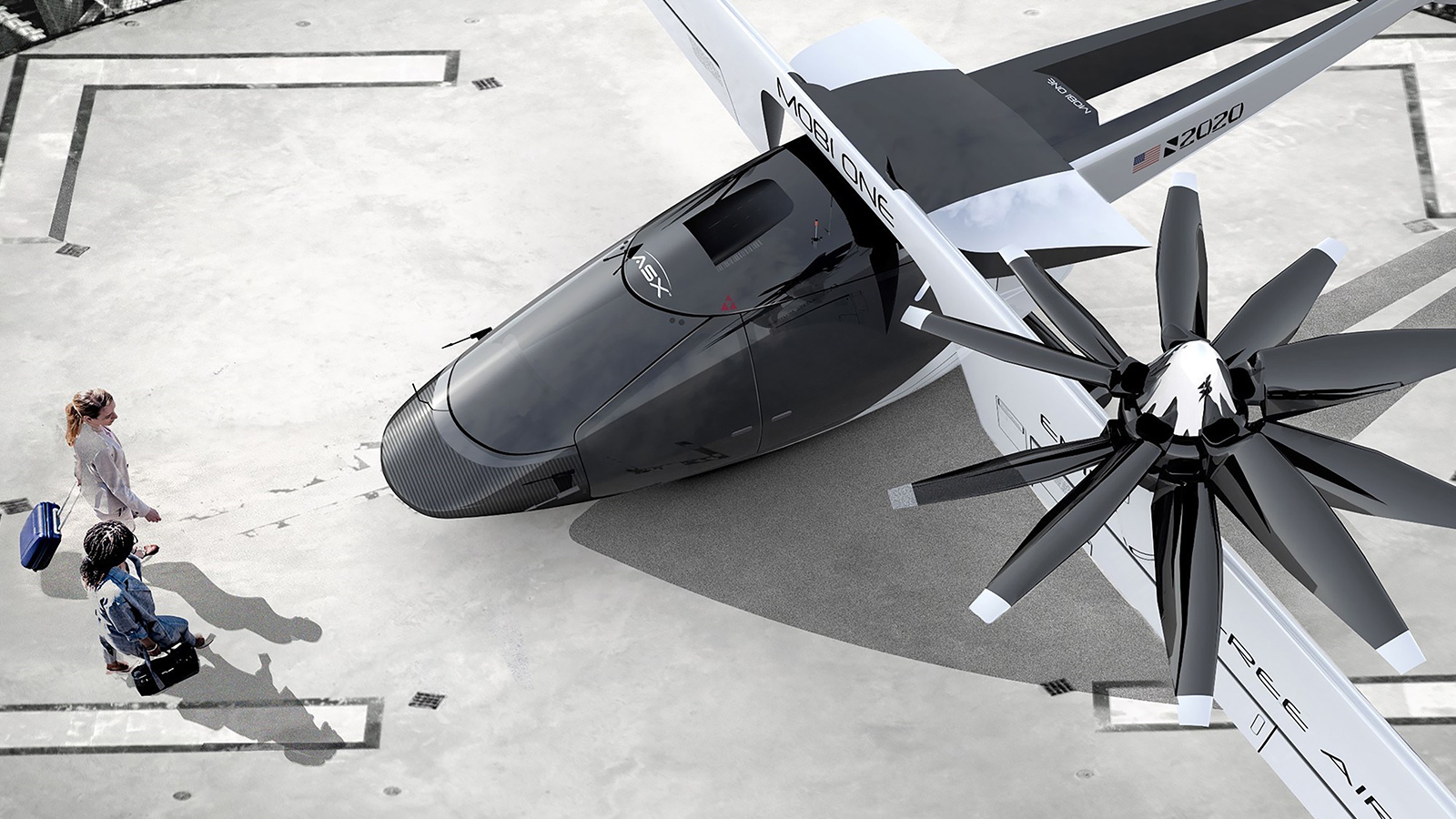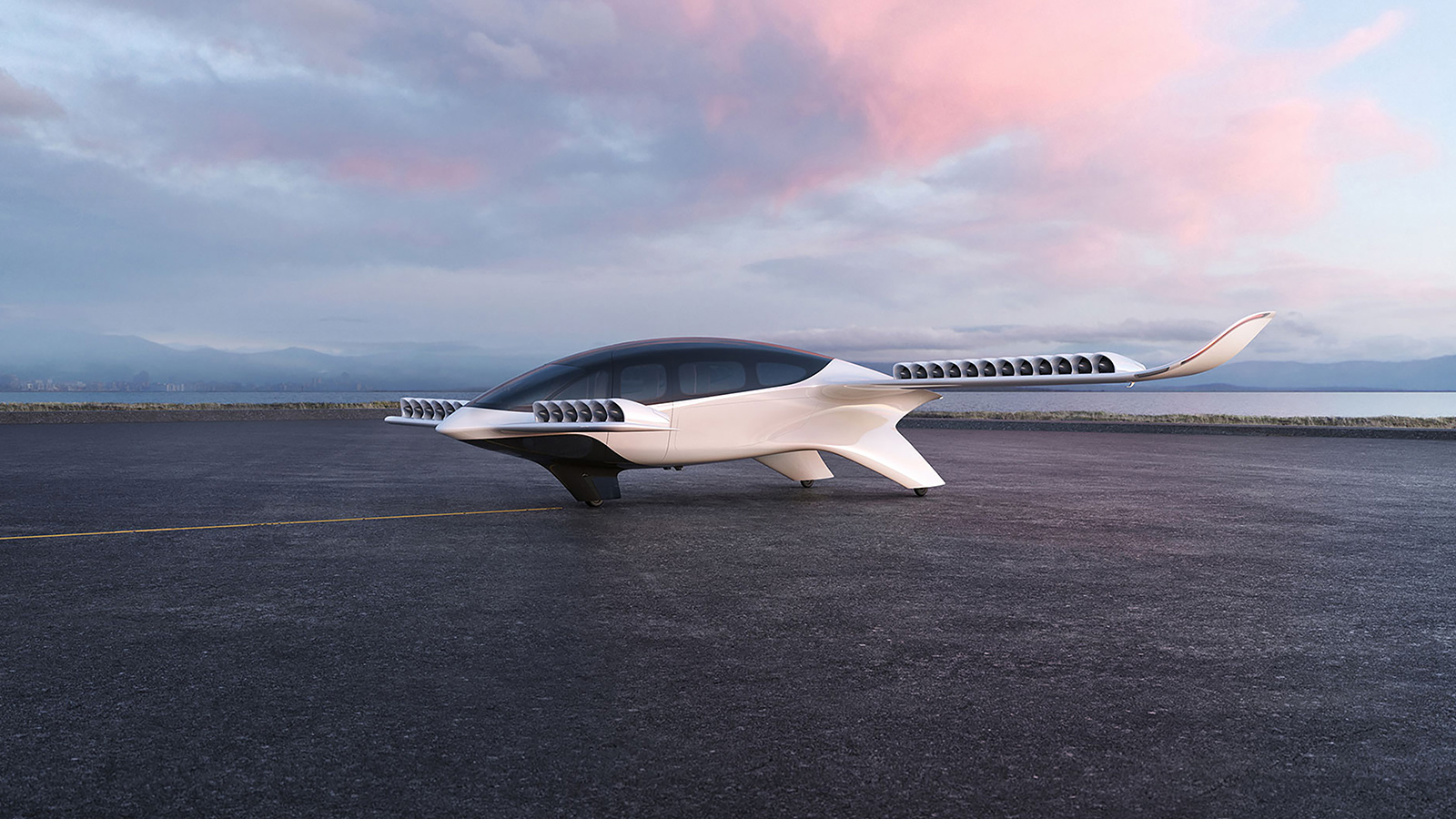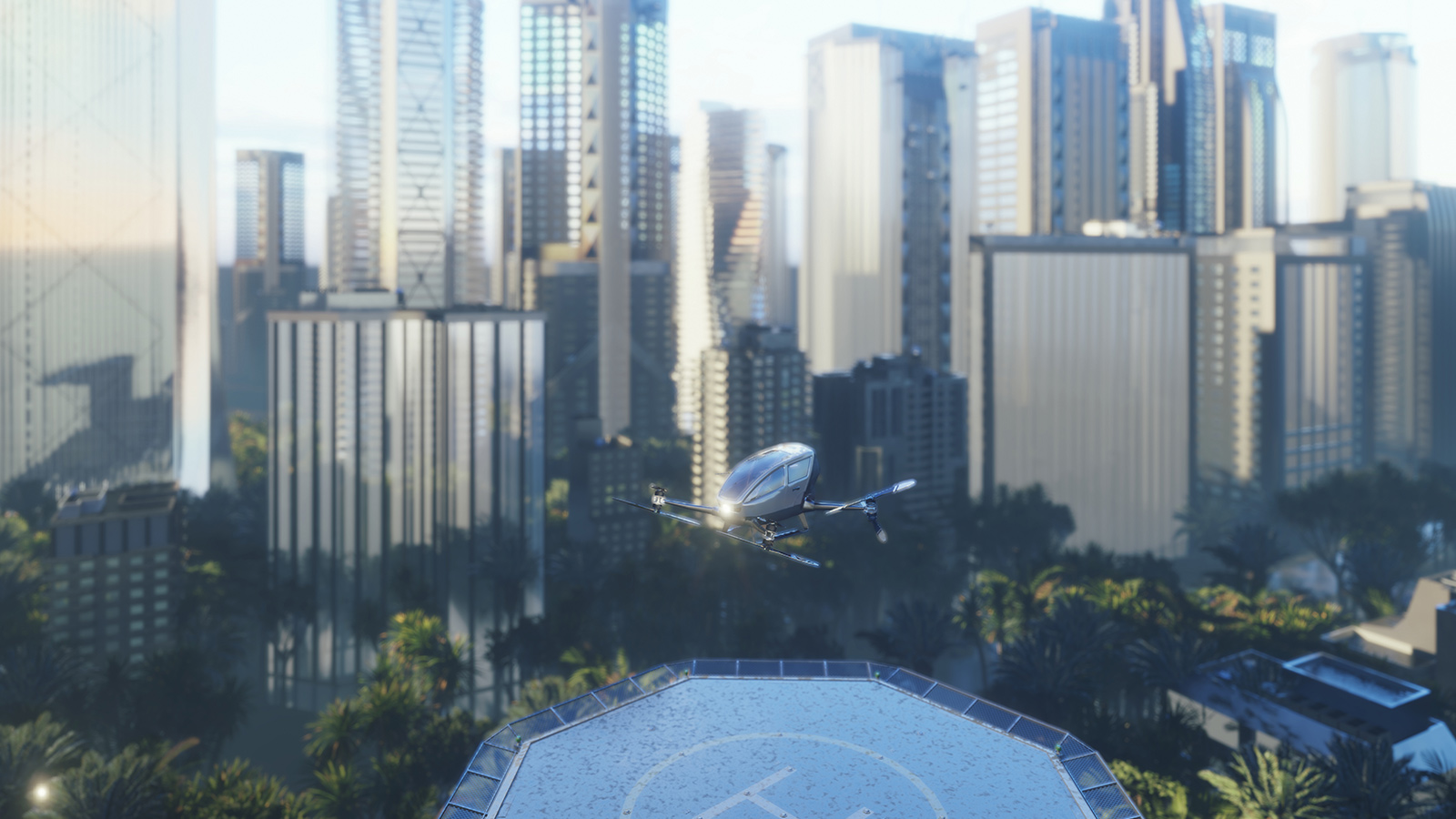Stay Up to Date
Submit your email address to receive the latest industry and Aerospace America news.
Startups are testing the coming breed of urban air mobility aircraft in their back lots and hangars. The harder part could be convincing potential passengers that these aircraft, with their whirling rotors, electric power and control algorithms, can safely deliver them to the airport or home from work. Sarah Wells tells the story.
The dream of personalized aviation in the U.S. was born the night Charles Lindbergh touched the Spirit of St. Louis down in Paris in 1927, according to a report published last year by the National Academies Press. Lindbergh’s achievement became most famous for demonstrating trans-Atlantic flight, but the feat also awakened the citizenry to the power of small aircraft to take them places locally, according to the report, “Advancing Aerial Mobility: A National Blueprint.”
Why drive or take a train when you could fly?
The authors note that interest in hopping between cities or towns on a whim in your Piper J-3 Cub or Cessna 120, for instance, remained high through World War II.
In fact, the U.S. General Aviation Manufacturer’s Association reported record high sales in 1946 of 33,254 aircraft. But this spike in sales did not last, and by the 1960s cramped commercial airliners were the predominant mode of flight for the masses.
Close to 75 years later, the dream of small, agile and instantaneous airborne transportation is experiencing a revival. Startups and historic aerospace institutions alike want to create an entirely new mode of transportation: urban air mobility. In most concepts, electrically powered, vertical lift aircraft, eventually steered by intelligent algorithms rather than human pilots, would shuttle handfuls of passengers from quiet suburbs into bustling cities or back home in minutes. These UAM concepts would be the boldest category under a broader heading of advanced air mobility services that NASA is seeking to nurture into existence for cargo and package delivery.
For the passenger versions, success will largely depend on whether developers can make potential passengers feel safe enough to board them, especially when it comes to trusting the autonomous pilot that would, in nearly all business plans, eventually take the place of a human at the controls.
Public perception
While engineers are hard at work testing aircraft designs and control software, researchers are doing what they can to gauge public opinion through market and human behavioral studies. Stephen Rice and Scott Winter, both professors at Embry-Riddle Aeronautical University in Florida, have conducted multiple studies on the underlying human behavioral factors that they believe will affect UAM adoption by the general public. In a 2020 paper, “A prediction model of consumer’s willingness to fly in autonomous air taxis” published in the Journal of Air Transport Management, they surveyed 510 people to determine how willing they would be to board an autonomous air taxi.
Rice and Winter found that approximately 46% of the survey participants would be willing to try an air taxi and that considerations like familiarity and fun factored heavily into that decision. Most participants, however, can best be summarized as having a “wait-and-see” attitude, the researchers say.
“A focus on the user experience, in addition to the engineering and technological design aspects, would be valuable efforts to encourage consumer buy-in and the success of urban air mobility,” they write in the study.
A Booz Allen Hamilton market study done for NASA in 2018 dug a little deeper into what exactly might be holding back a majority of potential passengers.
The company’s surveyors reached approximately 1,700 potential UAM passengers from Los Angeles, Houston, New York, San Francisco and Washington, D.C., who were largely unfamiliar with the current work being done in the UAM space. According to the report, as few as 23% said they were familiar with current UAM designs.
To bring all participants up to speed on current UAM designs, Booz Allen showed them a debranded commercial from Uber Elevate, the rideshare company’s UAM offshoot that it is selling to Joby Aviation of California, although the main Uber company will continue to invest.
With Uber’s logo removed, the commercial put the viewer in the shoes of a UAM passenger hopping on a flying rideshare for a commute home. After watching the 90-second commercial, the researchers asked participants about their perspectives on UAM automation, safety and even potential ownership.
Just as Rice and Winter discovered in their study, the Booz Allen Hamilton study found that passengers largely disliked the idea of a fully automated craft. By contrast, 77% felt they could be persuaded to fly in a UAM if a pilot (or a flight attendant) were onboard with them — a steep increase in adoption.
This discomfort around automated aircraft can be interpreted in two ways, as a distrust of automation itself as well as a distrust of fellow passengers in the absence of a human pilot or flight attendant, the report found.
Participants “expressed concern that passengers on board would cause harm to other passengers,” according to the report.
“Concerns about sexual assault were raised numerous times, particularly in an automated scenario without any flight crew on board,” the report said. “Interestingly, many focus group participants said they were unwilling to consider using any form of automated mobility (e.g., shared automated vehicles) for this very reason.”
UAMs pose a unique challenge compared to subway cars or buses because they are airborne, likely with fewer stops and opportunities to remove oneself from a dangerous situation. Also, because the vehicles will be small, passengers will be “unable to get up, if they feel uncomfortable or relocate to another seat or section of the aircraft.”
While experts, including Rice and Winter, estimate that UAM companies are at least 10 years away from this kind of automation on passenger craft, participants stressed in the market study that passenger screening protocol (akin to a diluted Transportation Security Administration experience) would be crucial to guarantee safety on these flights.
Trust in automation
As for fears of crashing in an automated aircraft, the Booz Allen surveyors found that the overwhelming majority of survey participants listed that as a top reason why they’d be hesitant to hop aboard a UAM vehicle. While cyber hijacking was also among the participants’ worries, the majority was more concerned about the aptitude of a fully autonomous pilot versus a human one, such as when flying through a storm.
Rice says that these kinds of views are driven by emotion, not necessarily logic.
This mistrust of autonomous control strikes some experts in the field as ironic, especially as studies on self-driving automobiles in recent years have demonstrated that relinquishing control over the wheel would be safer. A 2020 Insurance Institute for Highway Safety study concluded that as many as one-third of vehicle accidents in the U.S. could be prevented by automation.
One expert who feels this way is NASA’s Advanced Air Mobility mission manager, Davis Hackenberg.
“There’s a case to be made — and people have actually shown safety cases — for how ground-based detect-and-avoid and other detect-and-avoid autonomy can be safer than what we have today.”
Take the 2002 midair collision of DHL Flight 611 and Bashkirian Airlines Flight 2937 over Germany as an example, says Hackenberg.
Both flights were on a collision course when their Traffic Collision Avoidance System software coordinated a “resolution advisory” that recommended Flight 2937 should climb and Flight 611 descend. Flight 2937 received conflicting instructions from the human air traffic controller and descended instead — directly into Flight 611. German investigators found that if both flights had followed their TCAS instructions they would have narrowly avoided each other.
“Automation needs to make the aircraft safer; that’s the point of it,” says Hackenberg.
Hackenberg points out that while consumers may be fearful of automation as it appears in new craft, they are already (even if unknowingly) used to it in commercial airliners, which rely on such technologies as autopilot and automated power distribution.
Looking at the degrees of autonomy UAM aircraft should have, Matt Scassero, director of the University of Maryland’s UAS Test Site, says that there are five possible flavors ranging from the automation already included in many commercial aircraft today to a fully autonomous, thinking machine. This highest level of autonomy won’t be fully achieved anytime soon, but Scassero says he believes it will find its way into UAM vehicles when the technology is ready.
Until then, Scassero says that the trend of automation for UAM vehicles will be similar to that of subway trains.
“Eventually, like some subway systems today, you will get to that leap where there’s nobody in the car except for the passengers,” he says. “Most people today don’t even realize they don’t even think about it, because they’ve demonstrated the safety.”
Building trust
UAM companies will need to take a frog-in-boiling-water approach to automation if they hope to be successful — that is, increasing the level of automation bit by bit until they’ve reached a satisfactory safety level without passengers even noticing the change, Scassero says. For instance, Joby Aviation plans to start with human pilots in their aircraft.
In order for UAM companies to offer passengers autonomous flights as inexpensively as today’s ride-shares, Hackenberg says that autonomy will have to get both better and cheaper.
“I think it all boils down to safety and economics,” he says.
As for convincing passengers of that safety, Marilyn Smith, director of Georgia Tech’s Vertical Lift Research Center of Excellence, says that companies like Amazon and UPS are warming customers up to the idea of automated UAM vehicles by introducing them to automated delivery drones, a class of advanced air mobility craft. The idea is that these positive interactions will help customers build trust with UAM vehicles, which are in essence large drones equipped to carry people. In the U.S., drones are the only kind of fully autonomous craft with air space permissions to fly near inhabited areas, says Smith, all the while kept contained with geofence bumpers.
As for rolling out UAM services, countries in Asia such as Singapore and in the Middle East, mainly Israel, are closer than the United States to permitting autonomously flown passenger UAM services, which doesn’t bother Smith.
“The U.S. is a little more conservative and is trying a lot of this with package delivery and other humanitarian assets,” says Smith. “And to me, that’s actually the way to go. A lot of people are saying that the U.S. is too conservative in that aspect, but I think that is partly because, for the U.S. and the EU, human life is the No. 1 priority.”
Some companies might be tempted to set up friendly computer screens in their aircraft as a stand-in for flight attendants who, on commercial jets, are trained to help passengers escape the plane in an emergency.
Victoria Nneji, whose research at Duke University looks at the future of mobility and human interaction, says companies will need to go beyond that to convey safety as a priority. Instead, Nneji says, they must establish a culture of safety documentation, reminiscent of the air bag safety campaign automobile companies ran in the 1970s with crash test dummies. Done correctly, this would prove to passengers that autonomous UAM vehicles cannot be hacked or hijacked and that they are “smart” enough to fly through a storm without crashing, she says.
Attention to details unrelated to safety also will be critical.
“Even if it’s a small error that you notice about something with the interface, that can really reduce the trust that a person has in even taking that flight,” she says. A potential customer might wonder, “if the developers failed at this really simple test, how can I really know how well they tested the other safety critical functions?”
To win back trust, brand name recognition such as Uber or NASA’s involvement will go a long way toward building passenger trust and serve as good publicity, the Booz Allen researchers found. Luckily creating good publicity is something that Janet Bednarek, a professor of aviation history at the University of Dayton, says the aviation industry has plenty of practice with.
Before the popularization of commercial airlines in the 1960s with companies like Pan Am, it was common to see grisly aviation accidents (like the 1956 crash over the Grand Canyon that led to the creation of FAA) splashed across local front pages. To counter this bad press, the companies began to run ad campaigns with an emphasis on safety and professionalism of both airlines and pilots alike, says Bednarek.
“Between the 1930s and the 1970s, airlines placed a lot of emphasis on just how safe airplane travel was,” says Bednarek. “For example, [in ads] they would show that men, women, children, young, old, all kinds of people could travel by air, so that more Americans could essentially see themselves on the airplane.”
This marketing supplemented other advertisements that positioned the airlines as professional and reliable and crafted an image of pilots as friendly and responsible tour guides of the sky. Bednarek suggests that UAM companies could follow a similar tactic and help passengers truly envision themselves on these craft and to put equal trust into their autonomous pilot as they would their human counterpart.
A future saturated by autonomous urban aircraft is still at least a couple of decades away, in most opinions, but Rice, Winter and Smith say that we may begin to see more earnest testing of these aircraft with human passengers in the next five to 10 years. Only then will we finally know just how accurate all our predictions really are.
“Automation needs to make the aircraft safer; that’s the point of it.”
Davis Hackenberg, NASA’s Advanced Air Mobility mission manager
About Sarah Wells
Sarah is a science and technology journalist based in Boston interested in how innovation and research intersect with our daily lives. She has written for a number of national publications and covers innovation news at Inverse.
Related Posts
Stay Up to Date
Submit your email address to receive the latest industry and Aerospace America news.







